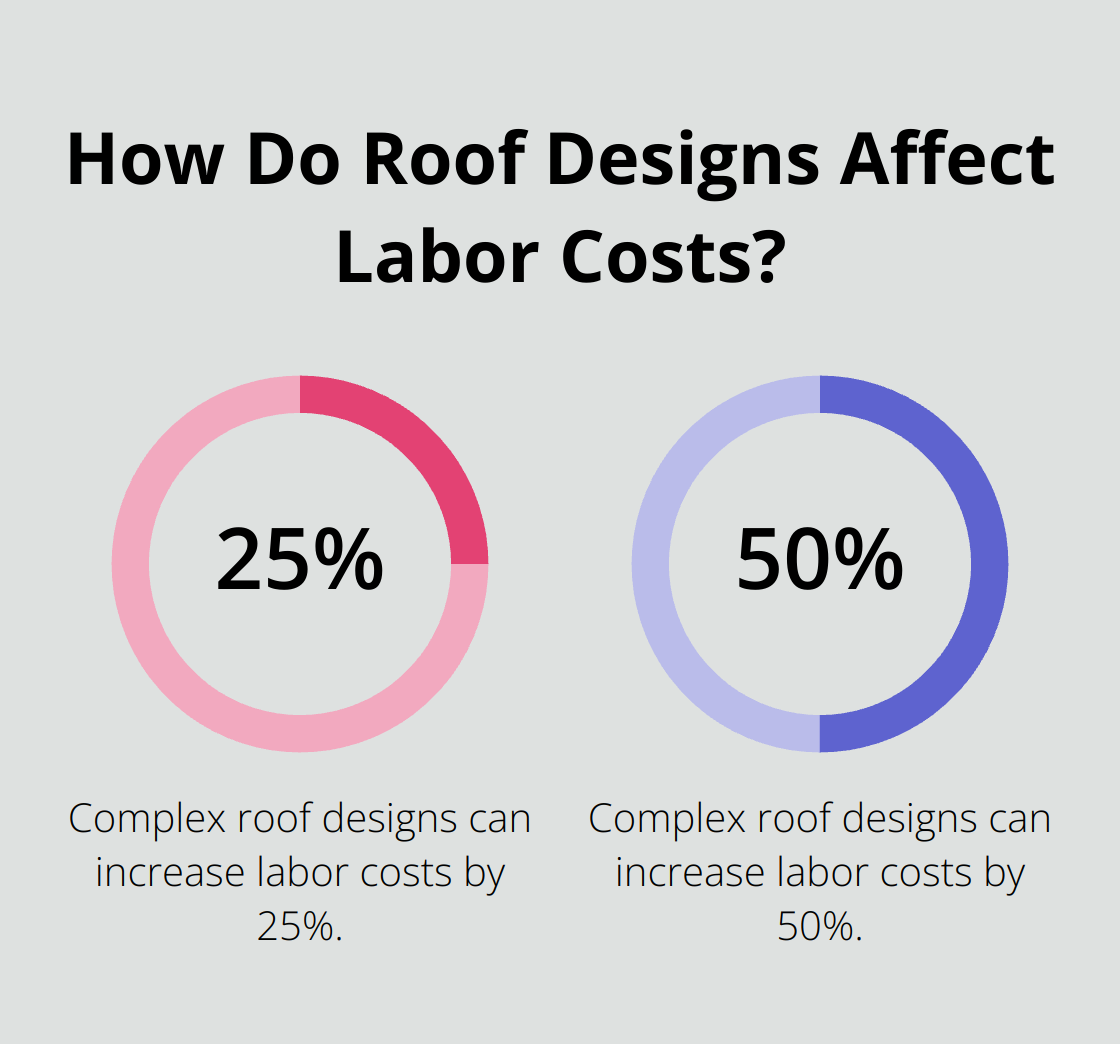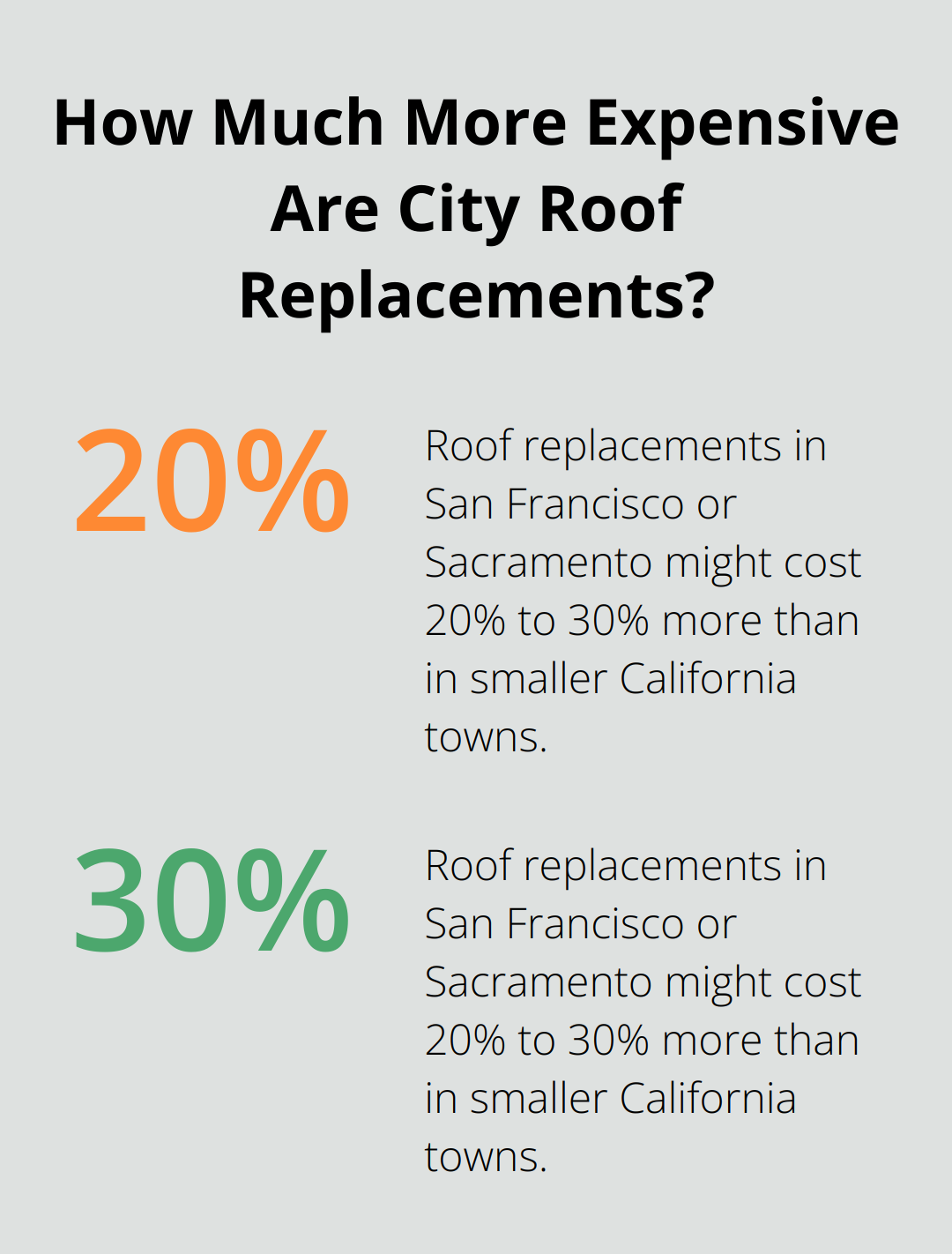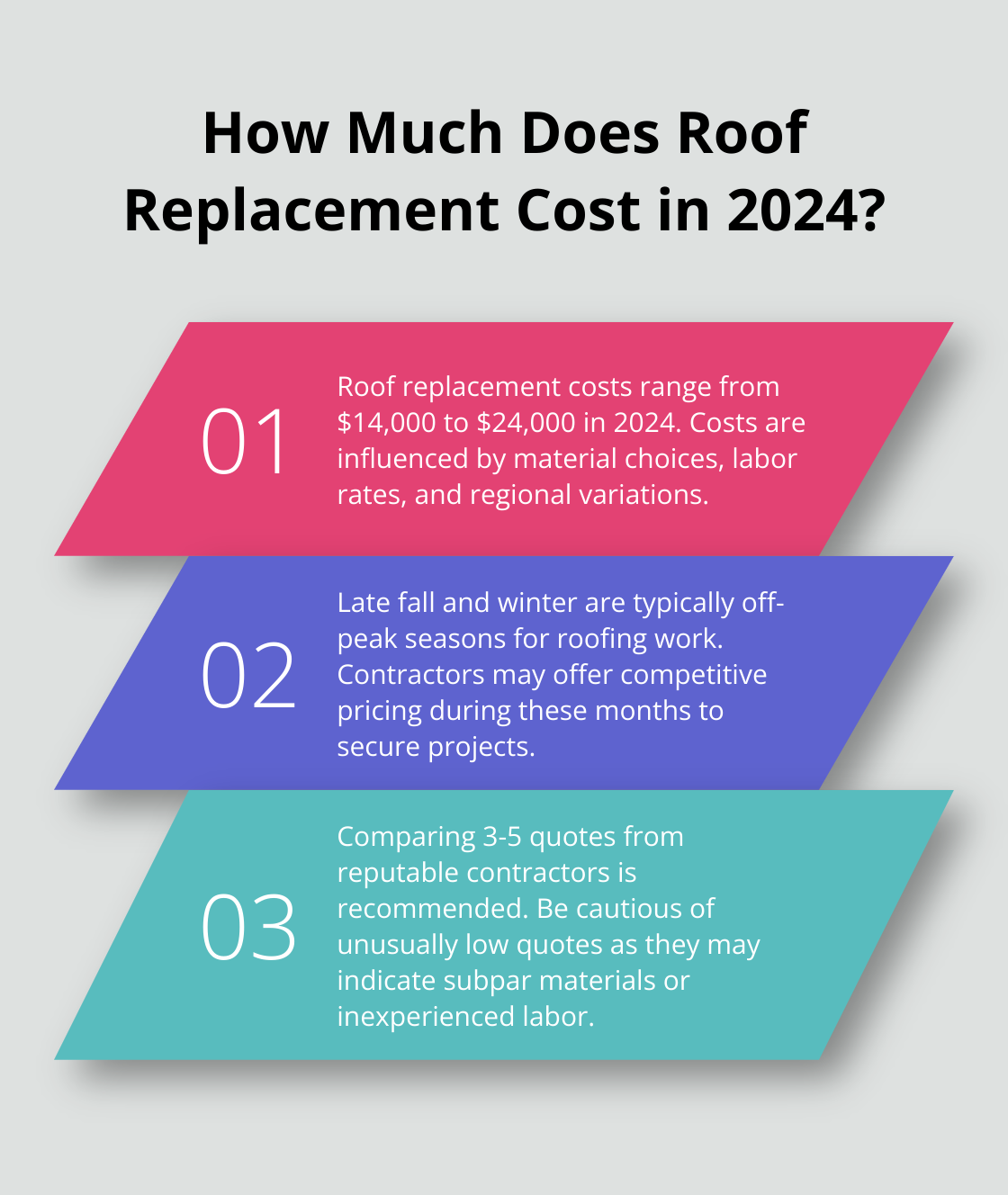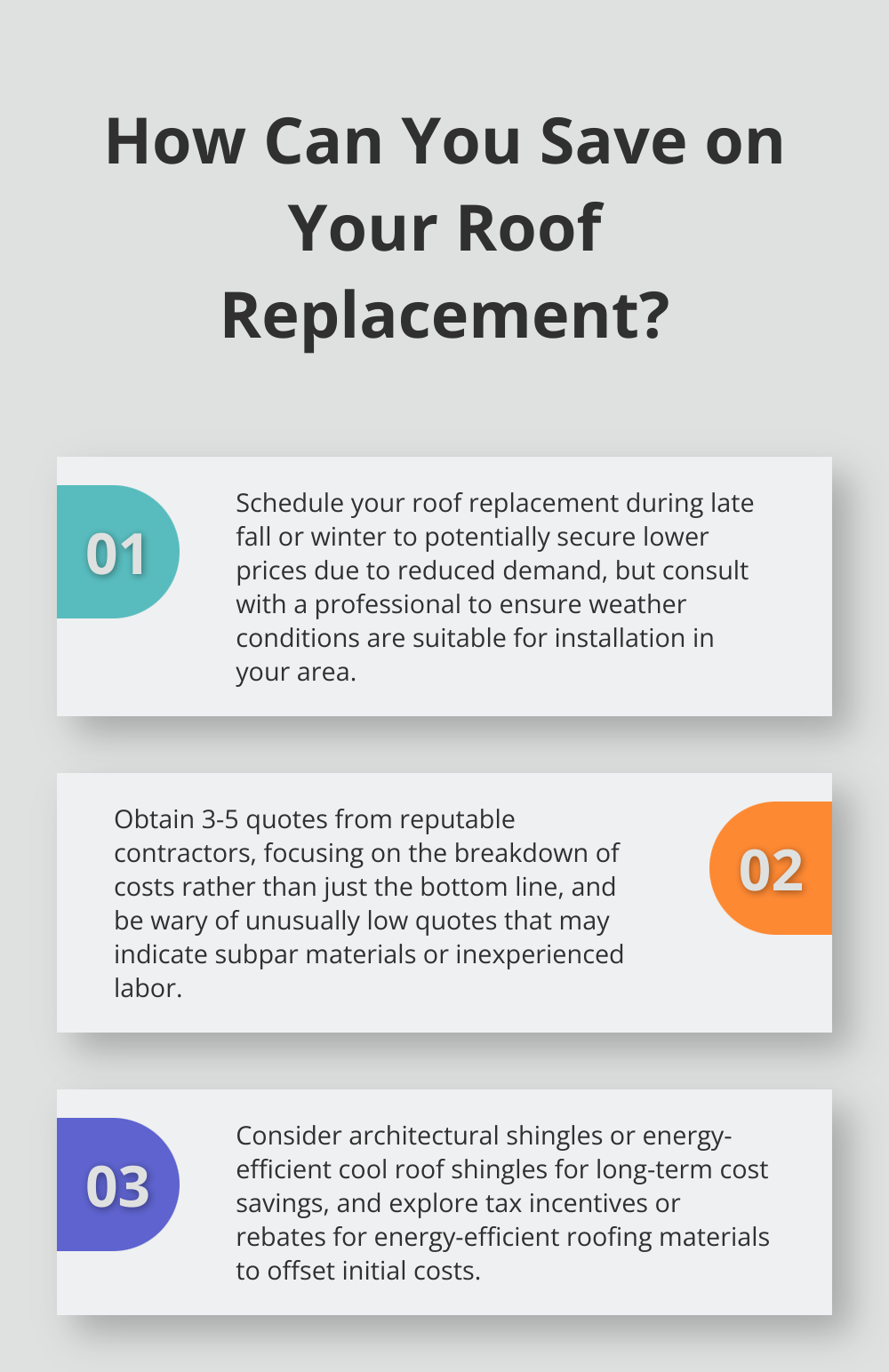Replacing your roof shingles is a significant investment in your home’s protection and value. At Grandmark Service Company, we understand that homeowners want to know what to expect when it comes to the average cost to replace roof shingles.
This comprehensive guide will break down the factors influencing costs, provide a detailed cost breakdown, and offer practical tips to help you save money on your roof replacement project.
What Impacts Roof Shingle Replacement Costs?
The cost of replacing your roof shingles depends on several key factors. Understanding these elements will help you budget effectively for your roofing project.
Roof Size and Complexity
The size of your roof is the primary cost driver. Roofing contractors measure roof size in “squares” (one square equals 100 square feet). A larger roof requires more materials and labor, which increases the total cost.

Roof complexity also plays a significant role. A simple, rectangular roof with few or no breaks in the plane costs less to re-shingle than a roof with multiple dormers, valleys, or a steep pitch. Complex roof designs can increase labor costs by 25% to 50%.
Shingle Quality and Material
The type and quality of shingles you choose significantly impact your project’s cost. Basic asphalt shingles typically cost between $1.50 to $9.50 per square foot. However, architectural or premium shingles can be more expensive.
For those seeking durability and enhanced aesthetics, options like metal roofing or slate tiles can cost more. While these materials come with a higher upfront cost, they often offer longer lifespans and better energy efficiency.
Regional Labor Rates
Labor costs vary widely depending on your location. Urban areas and regions with higher costs of living generally have higher labor rates. For instance, roofing labor in California or New York might cost more than in Midwest states.
Additional Materials and Services
Don’t forget to account for additional materials and services that are often necessary for a complete roof replacement. These can include:
- Underlayment
- Flashing
- Drip edge
- Removal of old roofing
- Permits
Some homes may require structural repairs or ventilation improvements, which can add to the overall cost. It’s important to have a thorough inspection before starting your project to identify any potential issues.
Understanding these factors will prepare you for your roof replacement project. While cost is important, quality shouldn’t be compromised. High-quality materials and professional installation can save you money in the long run by extending the life of your roof and preventing future issues.
Now that we’ve covered the factors that influence roof shingle replacement costs, let’s break down the average costs you can expect for different aspects of your roofing project.
How Much Does Roof Shingle Replacement Really Cost?
Replacing your roof shingles represents a significant investment, and understanding the costs involved can help you plan and budget effectively. Let’s break down the average costs you can expect for different aspects of your roofing project.
Shingle Types and Their Costs
The type of shingles you choose plays a major role in determining your overall costs. Asphalt shingles, the most common choice, typically cost between $150 and $600 per square. For a 2,000 square foot roof, this translates to about $3,000 to $12,000.

Higher-end options like architectural shingles can cost between $4.50 to $7.00 per square foot, pushing the total for the same 2,000 square foot roof to $9,000 to $14,000. Premium materials like metal or slate can significantly increase costs, often ranging from $9.00 to $20.00 per square foot or more.
Labor Costs: A Significant Portion of Your Budget
Labor typically accounts for a significant portion of the total project cost. Key factors influencing roofing labor costs include roof pitch and the complexity of the roof.
It’s important to note that complex roof designs or steep pitches can increase labor costs by 25% to 50%. Always get detailed quotes that break down labor and material costs separately.
Additional Expenses to Consider
When budgeting for your roof replacement, don’t forget to factor in these often-overlooked costs:
- Underlayment: $0.50 to $1.00 per square foot
- Flashing: $200 to $500 for an average home
- Drip edge: $1 to $3 per linear foot
- Removal of old roofing: $1 to $5 per square foot
- Permits: $250 to $500 (varying by location)
These additional expenses can add $1,500 to $3,000 or more to your total project cost.
Regional Price Differences
Your location significantly impacts roofing costs. According to recent data from Remodeling Magazine, the average cost for a mid-range roof replacement in the Pacific region (including California) is about $24,700, while in the East South Central region (including Tennessee and Kentucky), it’s around $20,000.
Urban areas typically see higher costs due to increased labor rates and material transportation costs. For example, roof replacements in San Francisco or Sacramento might cost 20% to 30% more than in smaller California towns.
Understanding these cost factors prepares you for your roofing project. While it’s tempting to opt for the lowest bid, quality materials and expert installation can save you money in the long run by extending your roof’s lifespan and preventing future issues. To ensure you’re getting a fair price for quality work, obtain multiple quotes from reputable contractors (like Grandmark Service Company, known for their impeccable installations and comprehensive warranties). Now that we’ve covered the costs, let’s explore some strategies to help you save money on your roof shingle replacement project.
How to Cut Costs on Roof Shingle Replacement
Time Your Project Strategically
The roofing industry experiences seasonal demand fluctuations, which affect pricing. Late fall and winter are typically off-peak seasons for roofing work. During these months, contractors often have more availability and may offer competitive pricing to secure projects. Roof replacement costs in 2024 range from $14,000 to $24,000, influenced by material choices, labor rates, and regional variations.

Weather conditions can impact the installation process. In regions with harsh winters, extreme cold can make shingles brittle and difficult to work with. Always consult with a professional roofing contractor to determine the best time for your specific location and project needs.
Compare Multiple Quotes Wisely
One of the most effective ways to ensure a fair price is to obtain multiple quotes from reputable contractors. Try to get at least three to five estimates to get a clear picture of the market rates in your area. When comparing quotes, look beyond just the bottom line. Pay attention to the breakdown of costs, including materials, labor, and any additional services.
Be cautious of quotes that seem unusually low, as they may indicate subpar materials or inexperienced labor. The goal is to find the best value, not necessarily the lowest price. A slightly higher upfront cost for quality work can save you money in the long run by reducing the need for repairs and extending the life of your roof.
Consider Alternative Shingle Materials
While asphalt shingles are the most common roofing material, exploring alternative options could lead to long-term savings. For instance, metal roofs may have a higher upfront cost but lower maintenance needs, while asphalt shingles are cost-effective initially but may need more frequent replacement.
Another option to consider is architectural shingles. These shingles are thicker and more durable than standard three-tab shingles, offering better wind resistance and a longer lifespan. While they cost more upfront, their extended durability can make them more cost-effective in the long run.
If you prefer asphalt shingles, consider opting for energy-efficient cool roof shingles. These shingles are designed to reflect more sunlight and absorb less heat, potentially reducing your cooling costs.
Explore Financing Options and Incentives
Financing your roof replacement can help spread the cost over time, making the project more manageable. Many roofing companies offer financing options, often with competitive interest rates.
Check for available tax incentives or rebates for energy-efficient roofing materials. The federal government and many states offer tax credits for installing Energy Star-certified roof products. These incentives can offset a portion of your roofing costs while also reducing your long-term energy expenses.
Don’t forget to check with your homeowner’s insurance provider. If your roof replacement is due to storm damage or other covered events, your insurance may cover a significant portion of the cost. Always document any damage and file claims promptly to maximize your chances of approval.
Final Thoughts
Replacing your roof shingles requires careful consideration of various factors that influence the average cost to replace roof shingles. The size and complexity of your roof, quality of materials, and regional labor rates all play a role in determining the final price. Professional installation is essential for ensuring the longevity and performance of your new roof, potentially preventing future issues and extending its lifespan.

Quality materials and expert installation may cost more upfront but offer substantial long-term value. A well-installed roof can withstand harsh weather, improve energy efficiency, and enhance your home’s curb appeal. It can also increase your property value and potentially lower insurance premiums.
Grandmark Service Company provides roofing services in the Fresno and Sacramento areas. We offer installations and warranties to homeowners (subject to terms and conditions). You can manage costs by timing your project, comparing quotes, exploring material options, and investigating financing and incentives.

